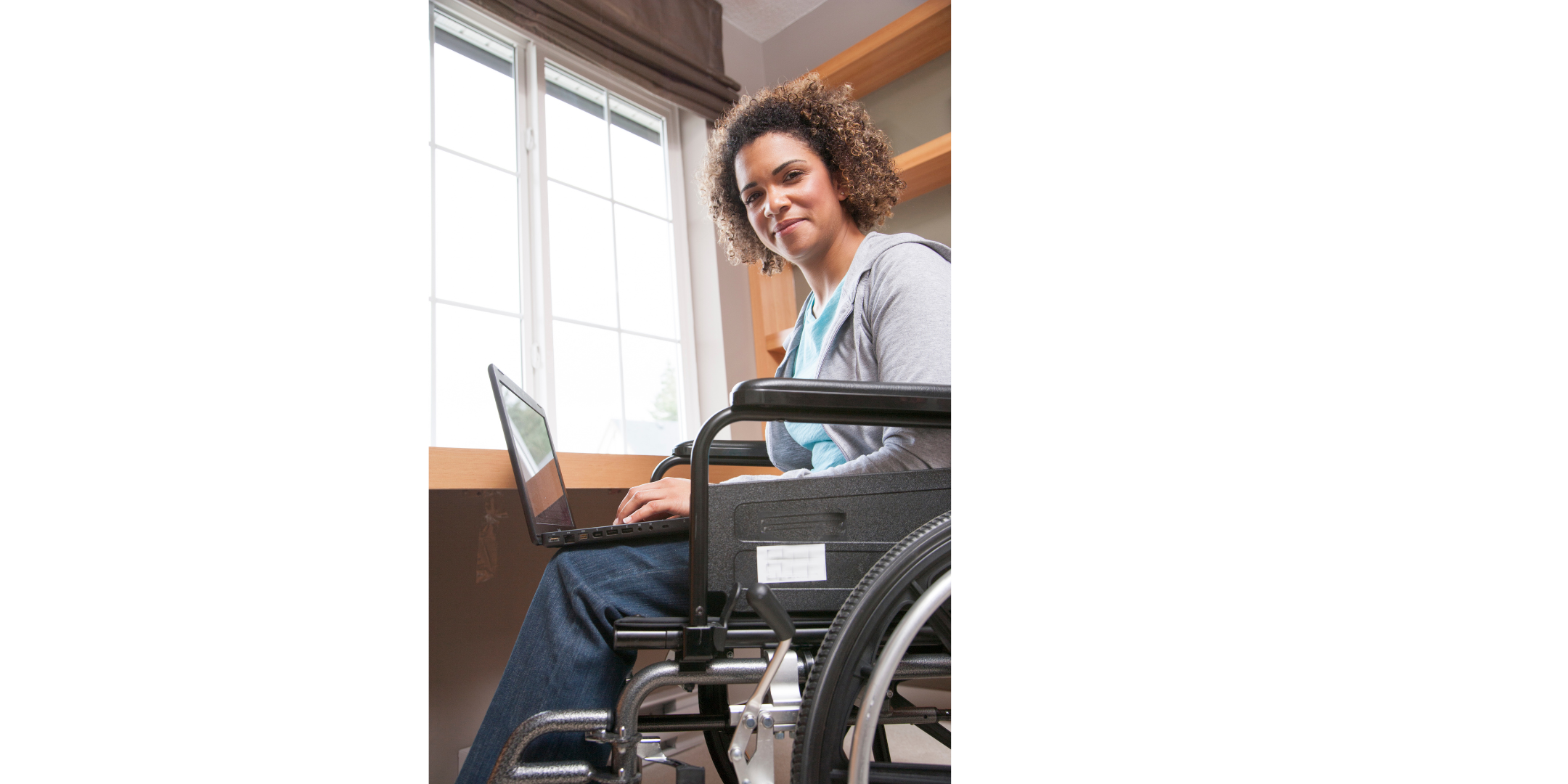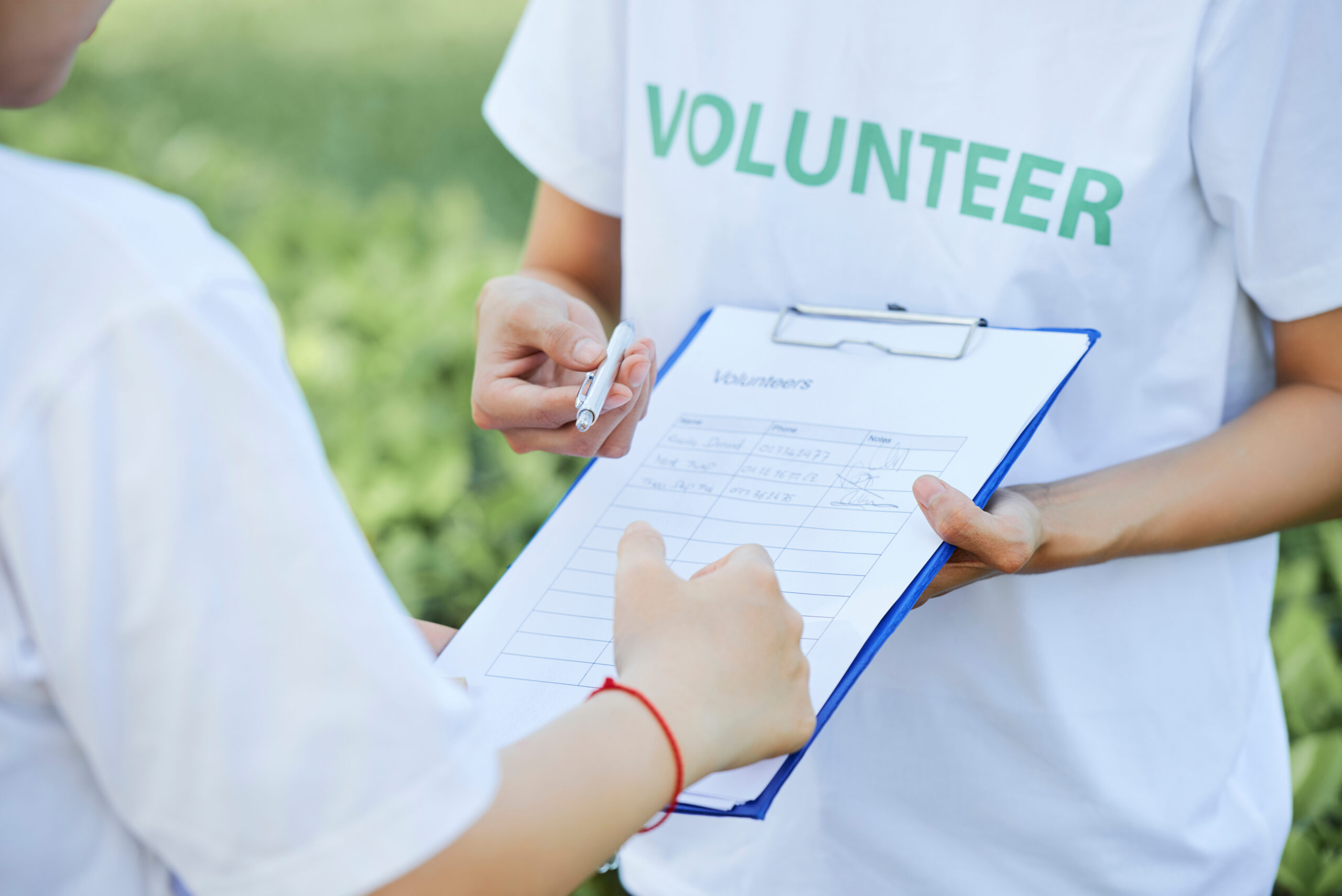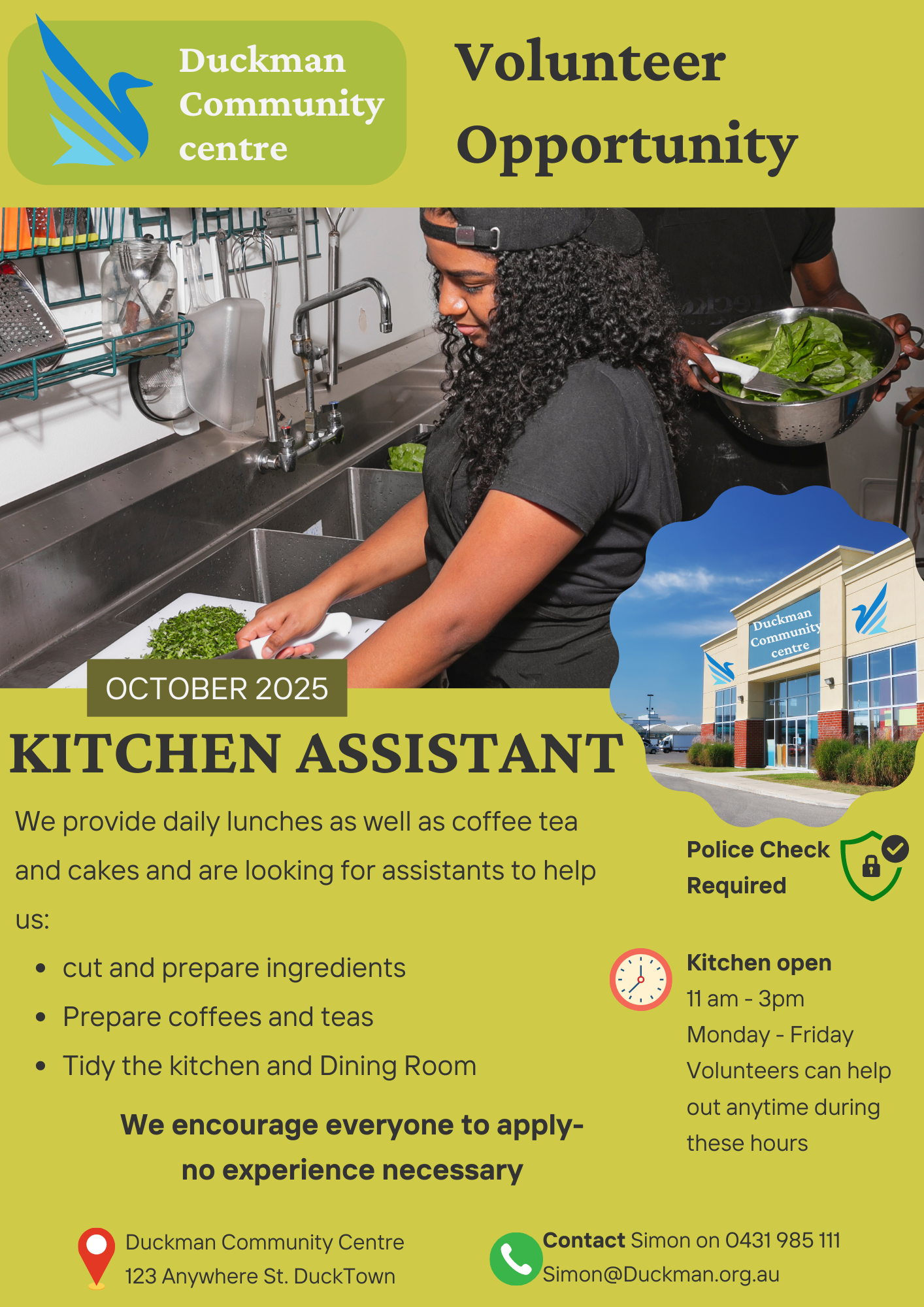Recruitment and Onboarding
For your volunteering program to be inclusive, you need to make sure everyone and anyone can apply, and if successful, come on board. Keep processes simple to make it accessible for everyone, not only people with disability.


Advertising volunteer roles
Clear, detailed and engaging online volunteer advertisements are one of the most essential methods of recruitment but can also act as one of the biggest barriers. Your advertisements and volunteer vacancy posts need to answer all of the important questions a volunteer may have about the role. Be sure to include:
- A role title that conveys what the role involves – Make sure prospective volunteers can picture the role just from the title. Avoid simply saying “volunteer” or “program assistant”, instead use titles like “gardening program assistant”, “companion for older people”, or “community bus driver”.
- A brief introduction to your organisation/program – Provide a few key details about what your organisation does, and how the volunteer role fits in.
- The tasks that a role could involve – Describe what a typical volunteer shift in the role will involve. Include a reminder that tasks can be adjusted to suit the volunteer.
- When the volunteering will occur – Include the day(s) of the week, the available shift times, whether times may vary, and whether adjustments can be made to suit the volunteer (e.g., shorter shifts or a mid-shift break).
- Provide options for people to contact you – Include an email address, phone number and/or address, so that people can find out more information about the role prior to applying, for instance to determine the accessibility of your facilities.
- Avoid unnecessary role requirements – While there are necessary role requirements, such as holding a valid driver’s license for a role that involves driving, often requirements are just copied and pasted into every volunteer role without reviewing the position description. You may be limiting your pool of applicants unnecessarily or creating barriers to participation for people with disabilities.
- If possible, include a photo of volunteers in the role – For people with low literacy, a photo that clearly demonstrates what the volunteer role may involve can be very helpful.
- Click here for examples of volunteer advertising

Ideally, you will have photos of your own volunteers -remember to get media consent if you haven’t already – click here for a media consent form. If you don’t have photos, ask your marketing department or organise a day to take some images of typical volunteer roles. Try to include a diverse range of volunteers – ages, genders, abilities and cultures– “you can’t be what you can’t see!”.
If you can’t arrange your own photos, there are a number of websites where you can download free images or pay a fee.
https://www.pexels.com/
Don’t have someone confident with technology to create eye catching documents? Contact your local High School and ask if students would like to support your organisation. Or recruit someone within your organisation or create a new volunteer position.
For more information regarding accessible and inclusive language check out our resource pages.

Advertising Flyers
When creating flyers for potential volunteers, it is important to consider the accessibility of the flyers you create. Below is an example of a flyer as well as improvements that can be made.
For more information check out our accessible communications resources

Example Flyer
This flyer is our example of the same flyer that has been tweaked to be more accessible.
contrast: the colour of the background and text isn’t very good- ideally dark and light colours make for easier reading, especially for people who are colour blind.
Text: the text choices are hard to read and small in places
Pictures: the pictures aren’t relevant to the role and give no context
Contact: there is only 1 method of contact and no address
Missing: the role requirements aren’t relevant to the role and the main duties aren’t outlined. There is also no times or days required for the role.

Example Flyer
This flyer is our example of something that isn’t very accessible.
contrast: the colour of the background and text is dark and light. making for easier reading.
Text: the text choices are simple and legible
Pictures: the pictures are relevant- one shows a main activity, the other the front of the building.
Contact: there are two contact options, a name to ask for and the address
Additional Details:
- there are icons showing where information is located, making it easy to find the information.
- The role is clearly outlined with main duties and times needed for the role.
- The applicant type they are looking for.

Expressions of Interest and Applications
One of the biggest barriers volunteers face when starting out is lengthy and complicated application processes. We recommend allowing potential volunteers to submit a short Expression of Interest (EOI), and then gather more details once you’ve decided to move them to the next stage of your process.
For expressions of interest (EOI), consider:
- Keeping it simple – Ask for volunteers: name, contact details, and a few sentences about their interest in volunteering. EOI’s are just the initial point of entry and should be a simple a way for people to flag their interest.
- Include only essential details/requirements – There may be details and specific requirements that are important to find out initially. If you do need to include a requirement, make it easy e.g., if your program only operates at a specific time or day, you may need a check box to confirm the volunteer is available at that time.
Keep in mind that many people are wary of sharing personal information online, like a driver’s license number, and most personal details can be gathered in the on-boarding stage.
- Having an open EOI option – It can be useful to have an option for people to say that they are interested in volunteering but aren’t sure what they want to do. Click here for an EOI template. This way you can meet with people, discuss their areas of interest, skills, goals etc. and find a way that they can help out. Find out more about creating and adapting volunteer roles here

For application forms, consider:
- Ask volunteers if they need any assistance filling in the application form and make time to sit with them and work through it or ask an experienced volunteer to help with this.
- If you want to ask about someone’s disability, health or medical concerns, we recommend a question like: “Is there anything we need to know in order to make your volunteering experience the best it can be?”
- Consider having different forms or questions for different roles (only gather the information you need for that specific role)
- Make it concise and use simple language.
- Click here for an application form template or check out more resources here

Include information about volunteering on your organisation’s website:
- Dedicate a webpage to volunteering and include all the information that prospective volunteers would need to know. This could include:
- An easy to find tab at the top of your website, or a heading in your main menu, that clearly says “Volunteering”.
- having photos and or videos of people doing the volunteer role.
- a list of volunteer locations and full addresses (for volunteers using public transport)
- a list of the different volunteer roles with a short summary of what each role involves.
- contact information for people to find out more (include various ways for people to get in contact)
- A clear link to submit an expression of interest

Don’t wait for people to come to you, reach out to them!
- Contact Disability Employment Services (DES) providers. Their role is to support people living with disability to find paid work. Part of this pathway may be to volunteer to gain experience, explore new careers and to improve confidence.
- There are other Government agencies who assist other people to find work too. These include:
Click on a link to see which agencies work in your area. Contact them to discuss your vacancies…. they might just have someone in mind!
- Contact your local Volunteer Resource Centre, Northern Volunteering or Southern Volunteering or volunteering peak body in your state , they can help with your volunteer recruitment and recommend how you can be more inclusive (membership fees may apply)
- Plan for walk ins. Who greets people at your organisation? Do they know how someone can express an interest in volunteering? If not, make sure everyone knows and is welcoming and encouraging.
- Become involved in community events. Find out if there are opportunities to join a local fete, expo or other event with a varied audience.
- Utilise your current volunteers, let them know you’re recruiting and ask them if they know anybody looking to volunteer. Ask them to share the volunteer vacancies on social media, or hand around flyers at their local clubs.
- Let interest groups or organisations that align with the role know: Need a gardening volunteer? Pop a flyer up at Bunnings – need someone to help in the canteen or kitchen? Let the local hospitality school know – Have a role where they can volunteer from home? Contact the local Playgroup to let parents of young kids know.
- These resources are based in the USA, but you may find some good tips about attracting volunteering at Tobi Johnson & Associates.

Inclusive interviews
As you are not recruiting for a paid role, you can be more flexible in your approach to volunteer interviews. You can use different interview formats so that each person has the best opportunity to show you why they’re a good candidate. Just like learning styles, people have preferred ways of communicating, and showing you how they could perform the volunteer role. Some suggestions are:
- Ahead of time send an email/text/or call explaining what the interview will involve, what they should wear, where the interview will be (parking and transport options, specific building, where they should wait/meet you, any access concerns) – Check out our template This may help ease the anxiety that some people may have about the interview process.
- Keep your question relevant to the role only, only ask questions that you really need to know, don’t worry if it’s short, keep it informal. – Check out examples of interview questions here
- Keep it casual, think of it more as getting to know a new volunteer and how they may fit in your program.
- Consider sending questions beforehand so the volunteer can prepare their responses.
- Have their form/details in front of you, so you know what information they have already provided
- Have multiple interview options e.g., over the phone, in person, zoom, write down and submit their responses via a survey monkey.
- Offer a no obligation “come and try” experience, which can be a great chance to see if the volunteer is a good fit, and for the volunteer to see if they would enjoy the role.
- ask them to bring along any ID they may need for checks.
- This is also a great chance to discuss the tasks a role involves, and whether they could be adjusted to suit the volunteer applicant, click here to learn more about adjusting volunteer roles

Declining a volunteer’s application
Sometimes, as much as you would like to provide an opportunity for someone, it’s just not a good fit.
It’s important to be open and honest as much as possible, while being diplomatic and caring. Don’t say “we’ve had too many people apply for this role and are unable to recruit all of the applicants” ….and then keep advertising for the role.
If you know that you have done your best to adjust the role and have thought carefully about how an applicant’s skills and availability can support your organisation, but you are unable to engage them, it’s OK to say no.
There may be many reasons a particular applicant is not a good fit, and in many cases it won’t have anything to do with their disability.
In a perfect world each volunteer applicant will already have all the skills and have no competing priorities on their time and energy. But I’m sure you already know this is not the case.
Wherever possible, communicate that a volunteer hasn’t been chosen for a role in person, or at the very least over the phone, rather than an impersonal email. Some wording to support you communicating to a volunteer that they haven’t been successful could be:
“Thank you for applying for XXX role with (insert org name). We enjoyed hearing about your skills. Unfortunately, because you are not able to:
Volunteer at a particular time and day
Complete the essential task of ……….
Comply with our procedure/policy of…………
We are unable to progress your application at this time.
